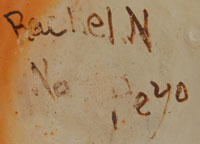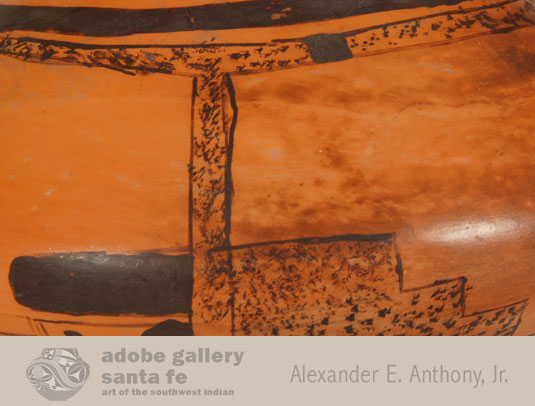Hopi Seed Jar with Monochromatic Design [SOLD]
+ Add to my watchlist Forward to Friend
- Category: Modern
- Origin: Hopi Pueblo, Hopituh Shi-nu-mu
- Medium: clay, pigment
- Size: 4-3/8” height x 7-5/8” diameter
- Item # 25966 SOLD
 Rachel Namingha Nampeyo was a granddaughter of Nampeyo and Lesso, a daughter of Annie and Willie Healing, and mother of Priscilla and Dextra. She was an expert potter who worked into her early 80s. Her work was exhibited in 1994 at the Smithsonian’s New York branch in an exhibit “Creation’s Journey: Masterworks of Native American Identity and Belief.” She has been published in numerous books, exhibits, and articles.
Rachel Namingha Nampeyo was a granddaughter of Nampeyo and Lesso, a daughter of Annie and Willie Healing, and mother of Priscilla and Dextra. She was an expert potter who worked into her early 80s. Her work was exhibited in 1994 at the Smithsonian’s New York branch in an exhibit “Creation’s Journey: Masterworks of Native American Identity and Belief.” She has been published in numerous books, exhibits, and articles.
Rachel was an accomplished potter, working into her 80s. This jar is most likely a later creation by her. To call it primitive would be incorrect as it was made by a potter who produced some magnificent pieces. This one, probably made late in her career, was made with the same love and determination as her earlier accomplishments. It was made by a potter who loved what she was doing even though she was less able to produce perfect pottery any longer.
 Age has a way of affecting the work of older potters but it does not affect their determination and love for Mother Earth and what can be made from her. Rachel continued potting into her late 70s because she did not know how to give it up. It was her love and her life. She must be admired for her life dedicated to making pottery. This jar is a representation of her work near the end of her life. It has special meaning because it represents her last works. If a retrospective of her life’s work were exhibited, this would certainly be included.
Age has a way of affecting the work of older potters but it does not affect their determination and love for Mother Earth and what can be made from her. Rachel continued potting into her late 70s because she did not know how to give it up. It was her love and her life. She must be admired for her life dedicated to making pottery. This jar is a representation of her work near the end of her life. It has special meaning because it represents her last works. If a retrospective of her life’s work were exhibited, this would certainly be included.
Condition: very good condition
Provenance: this Hopi Seed Jar with Monochromatic Design is from the collection of a family from Santa Fe
Recommended Reading: Hopi-Tewa Pottery 500 Artist Biographies by Gregory Schaaf.
Above, left, photo courtesy of Rick Dillingham, Fourteen Families In Pueblo Pottery.

- Category: Modern
- Origin: Hopi Pueblo, Hopituh Shi-nu-mu
- Medium: clay, pigment
- Size: 4-3/8” height x 7-5/8” diameter
- Item # 25966 SOLD



